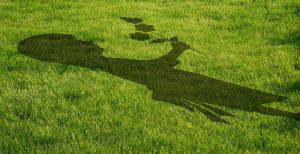Kentucky Bluegrass – you may have heard of the name before. That’s probably because whenever an American TV show or movie needs to reference a type of lawn, that’s their go-to. It’s the USA’s favourite cool season grass, and has been since time immemorial.
It actually started life as a native of Asia and Europe, where it is commonly known as meadow grass. While the cool season conditions seen through Asia, Europe and North America may not occur in many places in Australia, Kentucky Bluegrass is still highly suited to those areas that do have cooler climates in the south of the country.
Characteristics
Kentucky Bluegrass is known as a very good looking lawn, while also being super hardy and having the ability to repair itself very quickly. It can make a great companion grass if you’re thinking of seeding with multiple varieties. The deep green blades can often look as though they’ve got a blue hue, from which the name comes.
A unique trait for a cool season grass, it grows rhizomes – underground runners that allow the grass to spread, thicken the sod to produce a nice cushiony feel underfoot, and assist with the plant’s repair capabilities. At the same time these runners are nowhere near as aggressive as a Couch or Kikuyu warm season grass, so you shouldn’t find yourself battling to keep the turf within the confines of your backyard.
Shade Tolerance: Excellent
Daily Sunlight required: 4-8 hours
Drought Tolerance: Good
Frost Resistance: Excellent
Traffic Tolerance: Excellent
Lawn Care
Your standard good lawn care routine is a great place to start when caring for your Bluegrass, but there are some other considerations that you should note.
Kentucky Bluegrass generally enjoys higher than average nitrogen levels, so when you’re shopping for your fertiliser, try to go for something with a good percentage of nitrogen (the first number in the N:P:K ratio on the fertiliser bag).
If the blade of the grass starts to yellow, it may be a sign that your soil is too alkaline, which Kentucky Bluegrass doesn’t cope with particularly well. To counteract this, either giving the lawn a dose of Iron supplement or using a fertiliser with a high level of Iron should do the trick. If you’re looking for a fertiliser with high Iron content, look out for those marked “Winter Fertiliser.”
If you’ve got a patch of turf that is looking sparse or worn, reseed whenever is necessary.
You’ll need to mow your Kentucky Bluegrass far higher than most other grasses, with an ideal mowing height of between eight and 12 centimetres. A cool season grass that is most vigorous in Spring and Autumn, you may find yourself needing to mow up to once a week during these seasons if you are keeping with the old “cut no more than 1/3rd of the blade off” rule.
Bluegrass likes a drink, and needs a strong, reliable water supply to maintain its health and look its best. To keep it beautiful you will need to water for longer and more often than most Australian warm season grasses.
Having said that, Kentucky Bluegrass does have excellent drought tolerance. While it won’t look its best and it can brown off and go dormant easily, it will remain in that state for quite a while before it actually dies. If you’ve got a dead looking turf, be sure to give it a good water and see if it comes back before you dig it up and get rid of it.
Suitability
As mentioned, Kentucky Bluegrass thrives best in cool conditions that aren’t often found in the bulk of Australia. But if you’re from an area with milder summers and colder winters, like Victoria and Tasmania, then Kentucky Bluegrass may well be the ideal choice for you.
Click the link for more information on Kentucky Bluegrass and the suitability of your area, or consult the friendly team at McKays.


